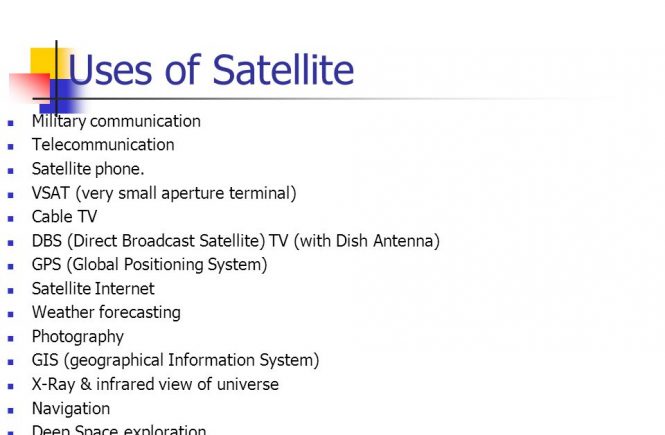Major Players of Satellites Communication A communications satellite is an artificial satellite stationed in space for the purposes of telecommunications. Modern communications satellites use geosynchronous orbits, Molniya orbits or low Earth orbits. Geostationary orbits The geostationary orbit is useful for communications applications because ground based antennae, which must be directed toward the satellite, can operate effectively without the need for expensive equipment to track the satellite’s motion. Especially for applications that require a large number of ground antennae (such as direct TV distribution), the savings in ground equipment can more than justify the extra cost and onboard complexity of lifting a satellite into the relatively high geostationary orbit. The first geostationary communications satellite was Anik 1, a Canadian satellite launched in 1972. The United States launched their own geostationary communication satellites afterward, with Western Union launching their Westar 1 satellite in 1974, and RCA Americom (later GE Americom, now SES […]
Radio and international communication & The battle of the airwaves
As with other new technologies, Western countries were the first to grasp the strategic implications of radio communication after the first radio transmissions of the human voice in 1902. Unlike cable, radio equipment was comparatively cheap and could be sold on a mass scale. There was also a growing awareness among American businesses that radio, if properly developed and controlled, might be used to undercut the huge advantages of British-dominated international cable links (Luther, 1988). They realized that, while undersea cables and their landing terminals could be vulnerable, and their location required bilateral negotiations between nations, radio waves could travel anywhere, unrestrained by politics or geography. At the 1906 international radiotelegraph conference in Berlin, 28 states debated radio equipment standards and procedures to minimize interference. The great naval powers, who were also the major users of radio (Britain, Germany, France, the USA and Russia), had imposed a regime of radio […]
TV or Television as a Medium for Education
Television is the audio-visual media of communication. It offers a window to the outside world. Among all the mass media, television attracts the largest number of viewers. It is the most popular and has the greatest potential. This is because it is able to attract the audience of all age groups, literate and illiterate and of all the levels of the society. Television has been given considerable importance in many countries as a source and a tool of teaching. Television is adaptable and can follow different approaches when used in the different educational situations. The medium is used for formal, non-formal and informal education. To support formal education, television usually function as supportive and reinforcement tool. Generally television can help to achieve the following objectives: 1. Social quality in education 2. Enhance quality in education 3. Reduce dependency on verbal teaching and teachers 4. Provide flexibility of time and space […]
EFFECTS OF ELECTRONIC MEDIA ON PAKISTANI SOCIETY
Effect OF ELECTRONIC MEDIA ON PAKISTANI SOCIETY “Media is all the more intense then atomic gadgets” I accept above quote merits taking. Jawed Jabbar who worked for PEMRA has cited well. The electronic media has touched each circle of the human viewpoint. In the present times, data and innovation are entwined with the general public’s financial advance. The development of electronic media has overwhelmingly affected the general public. The Opportunities of correspondence have broken all obstructions crosswise over national limits and have prompted the germination of new thoughts through the cross fertilization of societies. The part of media particularly the electronic media in Pakistani society is tri-dimensional; that is advising people in general, teaching the unknowledgeable and giving amusement. It can be named as Fourth mainstay of the state. It has recorded enormous development in a restricted era in Pakistan. The electronic media in Pakistan has gained fast ground. Just […]
Raw Materials for News story
News reporter to what extent would you go in search of raw materials for a news story? Reporters are always looking for news — that is, something “new” or “different.” So are their editors. Ideas that make it into the news are said to be “newsworthy.” For your project or research to make news, it has to be newsworthy in the reporter’s mind. What, exactly, fits the bill of being “newsworthy”? Of course, controversy makes news. But your work doesn’t have to be controversial to be “newsworthy.” Here are some other ways your research can be newsworthy: 1. Is it truly new — or a “new” way of thinking about an old issue? A recent story –“Do people need 8 hours of sleep a night?” — is an example of a research finding that was newsworthy. Reporters are interested in a scientific breakthrough that will affect the lives of […]
Cable Television
Cable Television Cable Television is a system for distribution of audiovisual information via coaxial cable. The system includes its signal receiving amplifying and controlling equipment and signal origination equipment. Since this system involves physical network and distribution of cables it is only operatable under government permission. Cables may be hurried underground or hanged with the poles. Amplifiers are placed to boost the signals at intervals along the cable. The essential features of Cable Television system < include headend for amplifying and processing signals for cable transmission, coaxial cable to carry the signals to subscribers terminal, equipment connected to subscribers' TV receivers and antennas. Headend, is the source of transmission. A studio for programme making can also be added with the headend. The basic difference between cable TV and broadcast TV is that the television signals are transmitted over cable rather than broadcast. Cable TV and CCTV (close circuit television) have […]
